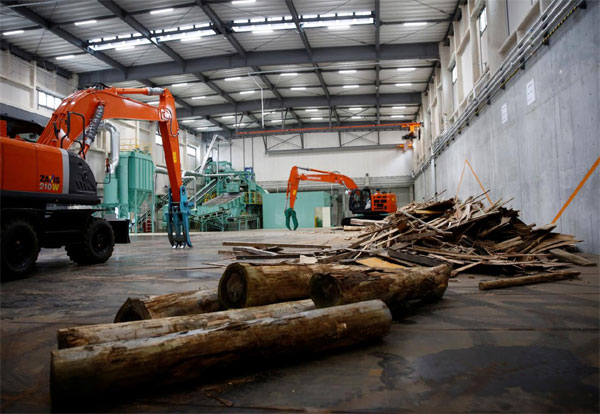As the sun sets on Japan’s solar energy boom, companies and investors are rushing into wood-burning biomass projects to lock in still-high government subsidies.

Collected wooden construction wastes are seen at Eco Green Holdings’s factory which makes wood chips from construction waste in Tokyo, Japan September 7, 2017.
More than 800 projects have already won government approval, offering 12.4 gigawatts (GW) of capacity — equal to 12 nuclear power stations and nearly double Japan’s 2030 target for biomass in its basic energy policy.
The sheer number of projects has raised questions about how they will all find sufficient fuel, mostly shipped in from countries like Canada and Vietnam, while some experts question the environmental credentials of such large-scale plants.
The projects approved to date that use general wood fuel would need the equivalent of up to 60 million tonnes of wood pellets, compared with global output of 24 million tonnes in 2014, said Takanobu Aikawa, a senior researcher at Japan’s Renewable Energy Institute.
Other fuels such as local forest thinned woods or palm kernel shells from Indonesia and Malaysia would not make up the shortfall, he said.
“There will be a scramble for fuels as countries like China and South Korea are looking to expand biomass power,” he said.
Biomass plants generate energy by burning fuels, releasing carbon dioxide into the atmosphere. They qualify as renewable because plants absorb CO2 as they grow, with a lifespan of years rather than the millions of years needed to make fossil fuels such as coal.
RUSHING IN
Echoing a similar surge in solar a few years ago, biomass applications jumped before an April rule change that requires an applicant to have a contract with a utility for grid connection, and the rush has continued ahead of a cut in the feed-in-tariff (FIT) on offer for large plants.
As with solar, companies that win early approval keep generous FITs for up to 20 years, while late-comers miss out. The solar FIT has been nearly halved since 2012, bringing the sector’s boom to an abrupt halt.
Trading houses such as Marubeni Corp, Sumitomo Corp and Mitsui Co have launched new biomass plants this year, while other firms including utilities, forestry and paper makers and construction companies are building or planning new stations.
Japan Renewable Energy (JRE), in which Goldman Sachs has a stake, is building its first biomass power station north of Tokyo, adding to solar and wind power plants.
“We are looking for other sites to build more biomass stations,” said Osamu Toribuchi, JRE’s general manager.
Major utilities, such as Chubu Electric Power Co, are also looking to co-fire biomass in their coal power plants to help cut emissions. Idemitsu Kosan, which supplies coal to utilities, is aiming to sell biomass fuel from next year, senior executive officer Shinichi Naruuchi said.
To capitalize on demand, local wood chip makers, traders and refineries are chasing long-term supplies of biomass fuel.
Sumitomo Corp bought a 48 percent stake in a Canadian wood pellet maker in July and is looking to invest in a similar company in Australia or New Zealand, said Katsunori Takamitsu, general manager for materials and supplies business development and promotion.
Japan’s Eco Green Holdings, which makes wood chips from construction waste, aims to triple its capacity by 2030 to 600,000 tonnes a year, said managing director Hirotaka Terashima.
BUBBLE FEARS
The surge has raised comparisons with the bubble in Japan’s solar sector, the first to take off in the wake of a push to renewables after the 2011 Fukushima earthquake and tsunami that virtually shut down the country’s nuclear industry.
Japan wants renewables to account for 22-24 percent of its electricity mix by 2030. Solar surged seven-fold in just four years to be about halfway to its 7 pct target, but new projects stalled after the FIT cuts, leading to bankruptcies among small contractors and suppliers.
Biomass has a 2030 target of up to 4.6 pct, and reached 1.8 pct by March 2016, mainly plants built before the 2012 FIT.
While biomass applications have also shot up, analysts say the higher barriers to entry mean that many projects will simply never be built.
“We don’t expect similar confusion to that seen in the solar sector,” Sumitomo’s Takamitsu said. “Only up to 30 percent of the approved capacity is likely to go online given difficulties to secure long-term fuel supply.”
Many applicants have neither plans to procure a 20-year feed of imported fuel or consent from utilities to connect to grids which are increasingly congested, industry experts say.
Analysts, meanwhile, warn that too big a rush to biomass could be self-defeating.
“The FIT is designed to enhance use of cost-effective renewable energy,” said Yukari Takamura, professor at Graduate School of Environmental Studies at Nagoya University.
“But if biomass operators use mainly imported fuels, energy costs may remain high and even help destruction of overseas forests.”
Source: Reuters